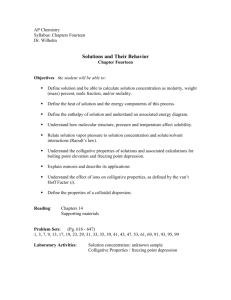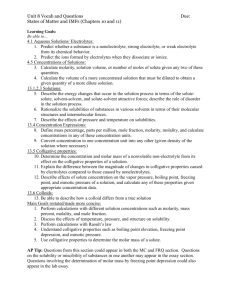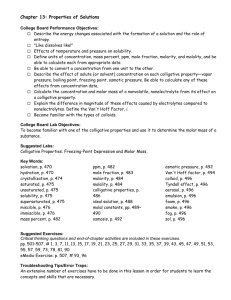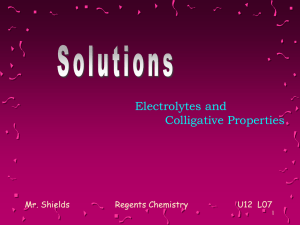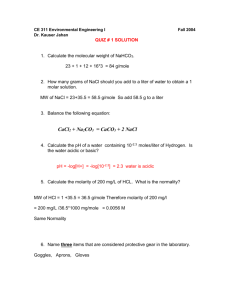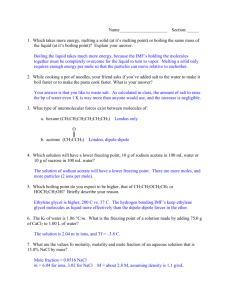Colligative properties a review lecture
advertisement
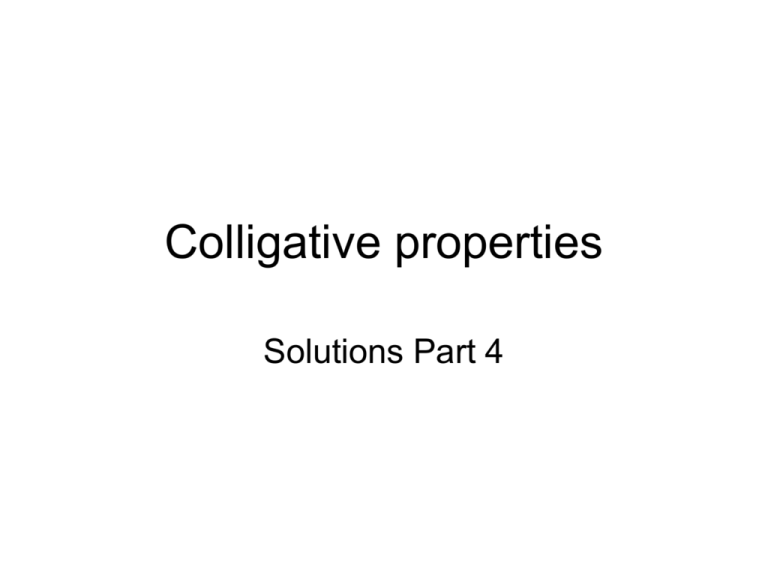
Colligative properties Solutions Part 4 Electrolytes: a quick review • Electrolytes form ions in solution. • Ions allow water to conduct electric current • Three types of electrolytes: strong , weak, and nonelectrolytes. Strong Electrolytes • Strong electrolytes ionize completely in water. • More ions in the water, more conductivity. • Strong electrolytes include: – Strong acids HCl H+ + Cl– Strong bases NaOH Na+ + OH– Soluble salts CaCl2 Ca2+ + 2Cl- Molarity:review • Moles per liter • 1.0 M = 1 mole solute per 1 liter solution. • Question • What is the molarity of 1.56 g of gaseous HCl in a 26.8 mL solution? Mole Fraction • mole fraction: the number of moles of a component of a solution divided by the total number of moles of all components. Example: • 58.5 grams of NaCl are in a one liter solution. • What is the Molarity of the NaCl? • 1M • 58.5 grams of NaCl are in 1800 grams of water. • What is the mole fraction of NaCl? • 1/101 Molality • Definition: a unit of concentration, defined to be equal to the number of moles of solute divided by the number of kilograms of solvent . This is not to be confused with Molarity Why so you add salt to an icy sidewalk? • • • • It melts the ice. How? Colligative properties. Why so some types of salt seem to work better than melting the ice than others. • Why? • Colligative properties. Colligative properties • are properties of solutions that depend on the number of molecules in a given volume of solvent and not on the properties (e.g. size or mass) of the molecules.[1] Colligative properties include: lowering of vapor pressure; elevation of boiling point; depression of freezing point and osmotic pressure. Colligative properties • How many ions are formed from the dissociation of 1mole of NaCl? • From CaCl2? • From NH4Cl • From H3PO4? Question • What is the concentration of each type of ion in the following solutions? • 0.50M Co(NO3)2 • 1 M Fe(ClO4)3 Answer • Co 2+ • NO3 - 0.5 M 1.0 M • Fe 3+ • ClO4 - 1M 3M • Why isn’t it 3M Cland 12 M O2- ?? Vapor Pressure Reduction • The particle act to attract the water molecules making it more difficult for them to free themselves to become vapor. Freezing point depression • The individual particles interfere with the water’s ability to form a crystal depressing the freezing point.
